Mazda’s new flagship three-row SUV, the Mazda CX-90 S Premium Plus, aims to blur the line between mainstream and luxury. Replacing the outgoing CX-9, the CX-90 rides on an all-new rear-drive-based platform and brings a level of style and craftsmanship that Mazda hopes will elevate its status with luxury SUV shoppers. Dressed to impress in top-tier S Premium Plus trim, it offers features like quilted Nappa leather upholstery and real wood accents, underscoring Mazda’s upmarket ambitions.
First impressions are strong; the Mazda CX-90 is a gorgeous SUV with smooth, flowing lines and classic long-hood proportions that draw admiring glances. Inside, the cabin makes a clear step upmarket for Mazda, with imaginative stitching details and chrome trim that wouldn’t look out of place in a luxury brand. From the driver’s seat, the CX-90 immediately feels special. Yet, as polished as this SUV is in comfort, style, and performance, a few surprising quirks, an odd shifter design, and some less-than-premium interior bits remind us that perfection remains just out of reach.
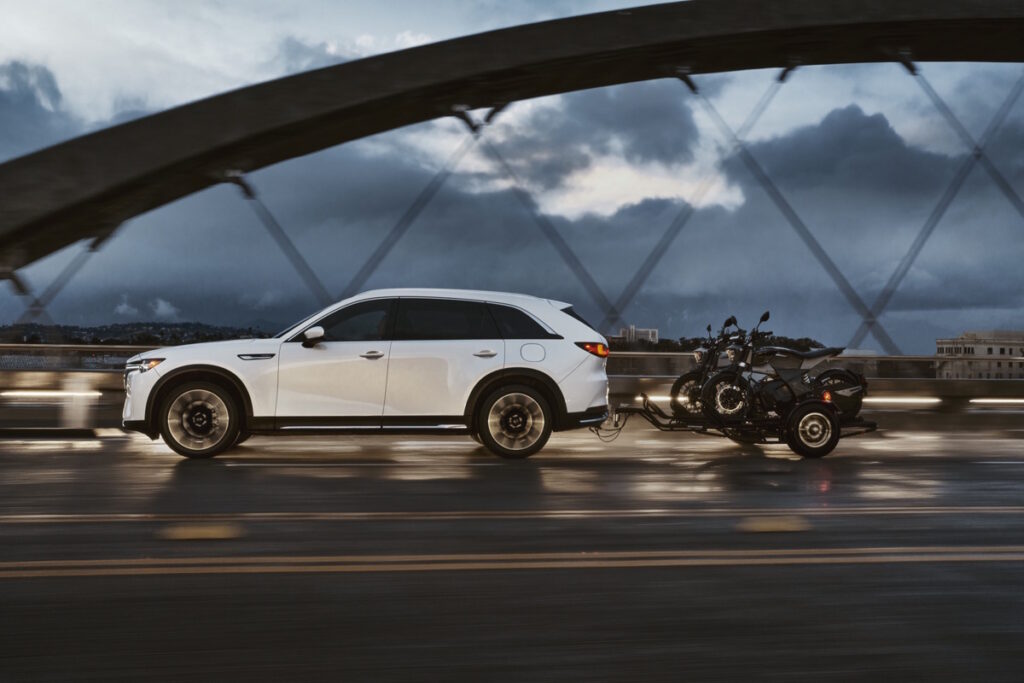
Driving Experience
Slide behind the wheel of the CX-90 S Premium Plus, and it’s evident that Mazda built this SUV for enthusiasts. Fire up the engine and the reward is a silky-smooth 3.3-liter inline-six that purrs with an almost European sophistication. With a substantial 340 horsepower and 369 lb-ft of torque on tap (on premium fuel), the CX-90 leaps ahead with effortless thrust. This top-spec powertrain is a joy – power delivery is linear and smooth as silk, and the six-cylinder’s refined growl is a welcome departure from the coarse four-cylinders in many rivals. An eight-speed automatic developed in-house by Mazda handles shifting duties. Most of the time, it’s a willing partner, calibrated well for spirited driving. Unlike many family SUVs, the CX-90 doesn’t shy away from a winding road; its balanced rear-biased AWD platform and taut suspension tuning make it genuinely enjoyable on twisty backroads, out-handling just about any competitor in its class.
That sporty tuning does come with some compromises. The steering, for example, is heavier than expected, especially at low speeds. While the heft gives a feeling of stability in sweeping curves, it can become tiring when maneuvering in tight spots or parking lots. The CX-90’s ride is also firmer than the class norm; you feel the road more directly than in a cushy Kia Telluride or Toyota Highlander. Most of the time, the ride is composed, even comfortable, but sharp bumps can register with an audible thump that reminds you of the sport-tuned suspension. Mazda clearly prioritized handling over a pillow-soft ride; enthusiastic drivers won’t mind, but family members might prefer a bit more cushioning on rough pavement. On the highway, the Mazda CX-90 tracks confidently with excellent high-speed stability. However, some testers noted that road and wind noise are higher than one would expect given the SUV’s near-luxury aspirations. The benefit of Mazda’s firm chassis approach is felt in corners: minimal body roll, quick reflexes, and a sense that the CX-90 shrinks around the driver, feeling more agile than an 8-passenger SUV has any right to. In this regard, Mazda delivers on its “driver’s car” reputation – a rarity among three-row crossovers.

Mazda CX-90: Interior & Comfort
Open the door to the CX-90 S Premium Plus, and you’re greeted by a cabin that’s artful and inviting. Mazda’s designers took some risks here, and they paid off. The dashboard in our tester is trimmed in a tasteful two-tone scheme with unique fabric stitching inspired by Japanese bookbinding, bisecting the dash with hanging stitches for a bespoke look. Real blond-wood accents with copper trim and soft Nappa leather surfaces create an ambiance that is equal parts solid and swanky, absolutely convincing as a premium space. In fact, the material quality is consistently excellent at first glance, and even in a pre-production model, journalists noted how upscale and well-constructed it felt. The front seats are extremely comfortable, supportive in all the right places, and suitably plush for long drives. Mazda also ensures that all three rows get attention: the first two rows in this trim are both heated and ventilated, and even the third row has its own air vents and USB ports, catering to passengers’ comfort. From the driver’s perforated leather steering wheel (now a bit thicker-rimmed, giving off a sporty vibe) to the tactile climate control knobs, most touchpoints in the CX-90 impart a sense of quality.
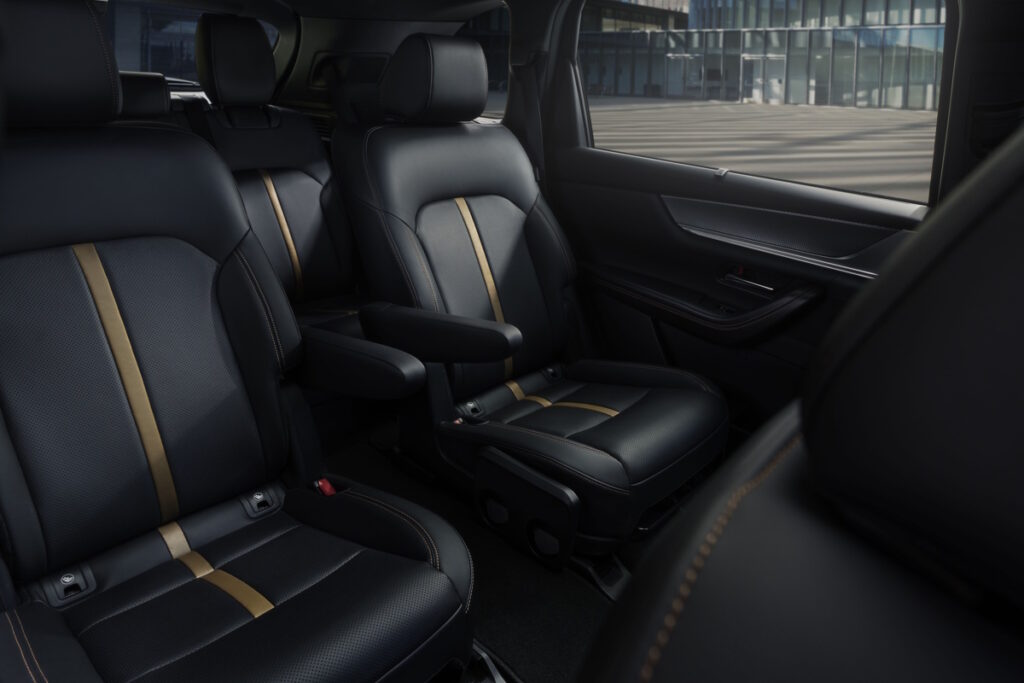
However, not everything inside lives up to the top billing. Some minor details betray the CX-90’s mainstream roots. For instance, while the upper dash and door panels are covered in nice materials, a few lower trim pieces, hard plastics (around the console and third-row area), and the shifter, feel a step below the luxury benchmark. It’s a small letdown in an otherwise posh interior, reminding us that Mazda isn’t a true luxury marque, at least not yet. There’s also the matter of space. Despite being one of the longest vehicles in its segment, the CX-90 doesn’t translate that length into class-leading roominess. The second row is plenty spacious and offers available captain’s chairs, but the third row is snug – adults will find the cushion low to the floor and legroom tight. It’s fine for kids or occasional use, but rivals like the Telluride, Grand Highlander, or Acura MDX offer more generous third-row accommodations. Cargo capacity is another sore spot. With all seats up, the CX-90’s cargo area is on the smaller side for the class. Mazda opted for style and performance over max cargo volume, and it shows. Families who routinely fill the third row or haul lots of gear may find the Mazda CX-90 less practical than boxier competitors. On the plus side, the seating comfort in the first two rows is superb, and Mazda did include thoughtful touches like window sunshades and multiple USB ports to keep everyone content. Overall, the cabin experience is a blend of luxury-car ambience and a few pragmatic compromises. It pampers you with its design and comfort, even if it doesn’t offer the outright space of some rivals.
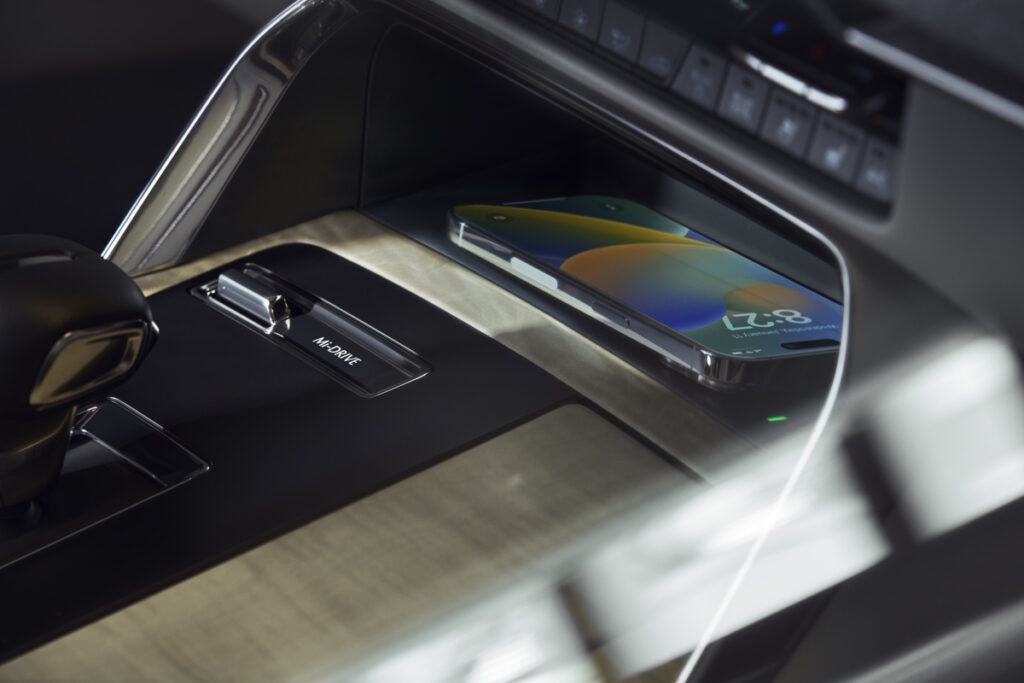
Technology & Features
In the tech department, the Mazda CX-90 S Premium Plus comes loaded with features expected at this price point. Our tester boasted a large 12.3-inch center display, a crisp head-up display, a 360-degree surround camera, and a full suite of advanced driver aids. The feature list is generous: tri-zone climate control, wireless phone charging, multiple driving modes, and a premium audio system all come standard on this trim. Mazda has clearly benchmarked the high-value Korean competitors when it comes to stuffing the cabin with gadgets – even the second-row seats in this trim are both heated and ventilated, a perk Telluride owners will find familiar with their SX Prestige models. Safety tech is comprehensive as well, with adaptive cruise control, lane-keeping assist, blind spot monitoring, and rear cross-traffic alert all included. Notably, Mazda’s lane-centering system performs surprisingly well, keeping the SUV neatly in its lane on the highway without the ping-pong behavior early Mazdas suffered. In slippery conditions, the standard all-wheel drive and stability systems inspire confidence, aided by the fact that Mazda even includes a spare tire – a small but meaningful nod to real-world practicality.
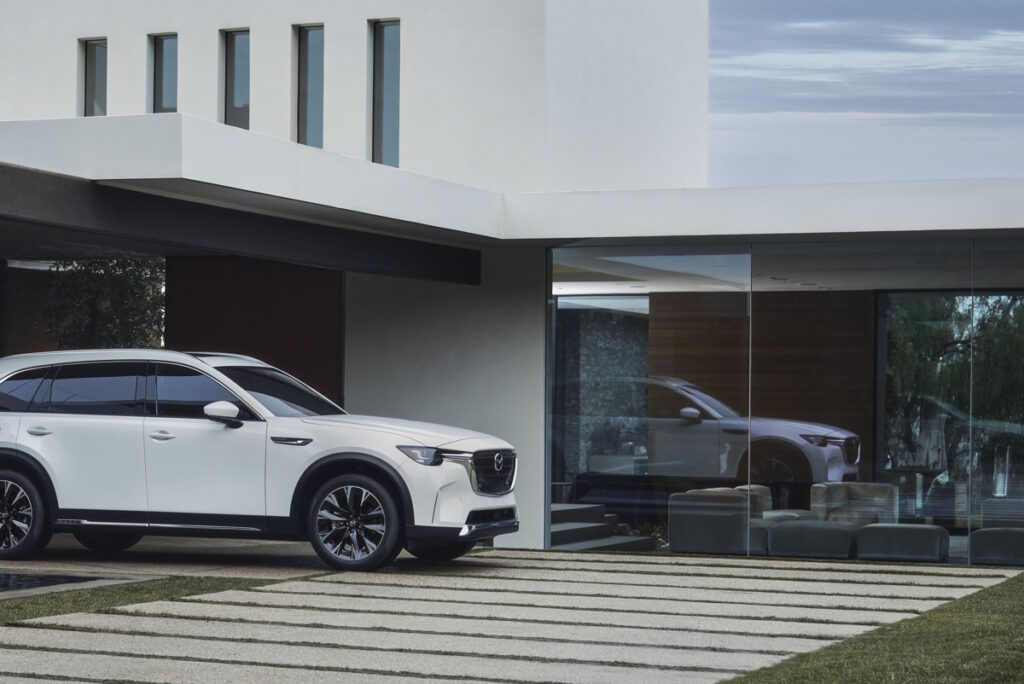
The infotainment experience, however, is likely the CX-90’s most contentious tech aspect. Mazda has stuck with its unique Mazda Connect interface, which is a hybrid of a clickwheel-controlled system and a touchscreen, but not at the same time. In most situations, you’re using the rotary dial on the center console to navigate menus on the widescreen display. The system looks elegant, with clean graphics and a high-resolution screen, but the user experience can be cumbersome and unintuitive. For example, something as simple as changing a radio station or jumping between playlists can require digging through layered menus via the dial. While Mazda did finally enable touchscreen capability for certain functions (like Apple CarPlay and Android Auto integration), it only works when the vehicle is stopped; in motion, you’re shackled to the rotary dial for input. This approach is ostensibly for safety, but it frustrates passengers who might want to quickly tap on the screen. In an era when competitors offer easy-to-use touchscreens with customizable displays, the CX-90’s system feels a step behind. “I hate this system,” one reviewer wrote bluntly, noting that even routine tasks demand too much attention from the driver. On the bright side, the head-up display and digital gauge cluster (which can even show a slick graphic of cars around you in the lane) are modern touches that enhance the driving experience. And Mazda’s suite of driver-assistance tech, like adaptive cruise and lane-keeping, is actually on par with the best on the market, including Hyundai and Honda’s excellent systems. It’s clear Mazda poured resources into making the CX-90 technologically competitive, but the infotainment interface remains a love-it-or-loathe-it quirk in an otherwise well-equipped SUV.
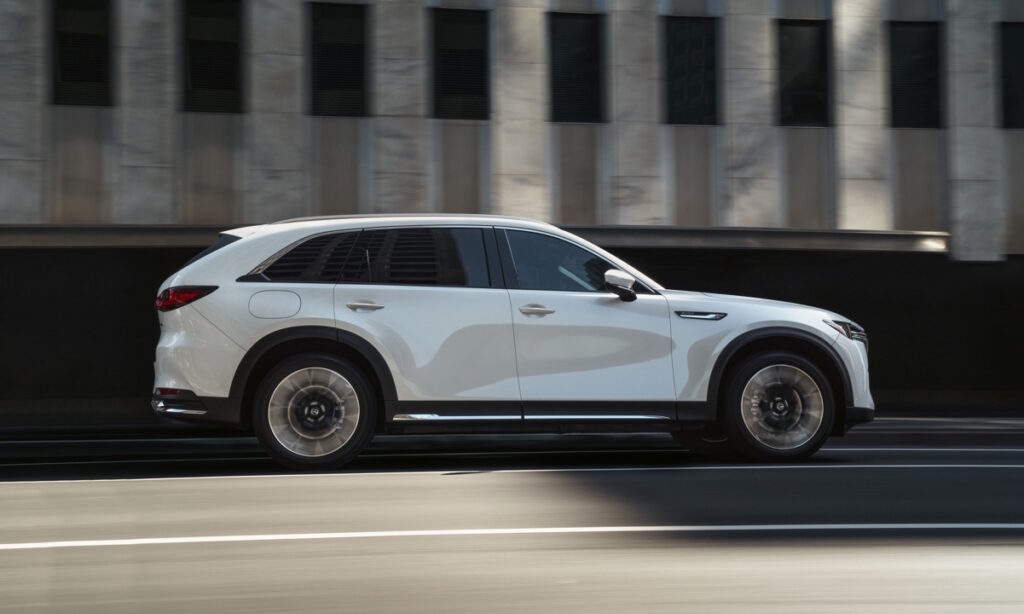
Comparison: Mazda CX-90 vs. Key Rivals
Mazda’s mission with the CX-90 is to entice buyers who might also be considering well-known three-row contenders. So, how does this enthusiast-oriented SUV stack up against some of the segment’s stars – the Kia Telluride, Toyota Grand Highlander, and Acura MDX? Each takes a slightly different approach to moving your family in comfort, so let’s see where the Mazda CX-90 shines and where it falls short by comparison.
Mazda CX-90 vs. Kia Telluride
Kia’s Telluride has been the darling of the segment since its debut, and it remains one of the most well-rounded, family-friendly SUVs you can buy. In a direct comparison, the Mazda CX-90 immediately distinguishes itself with its driving dynamics; simply put, the Mazda is much sportier and more engaging to drive. Its steering and chassis feel belong to a different category, whereas the Telluride prioritizes an easy, cushy ride. In fact, the Telluride delivers a smoother ride and a more family-friendly cabin, with roomier seating in all three rows. If your daily priorities involve ferrying a full crew in comfort, the Kia’s softer suspension tuning and exceptionally quiet cabin might win you over. The Telluride’s naturally aspirated V6 (291 hp) can’t match the CX-90’s turbocharged punch, but it provides adequate acceleration and a proven track record for reliability. Straight-line performance is in Mazda’s favor, the CX-90 is quicker, yet the Telluride’s V6 still offers decent towing (up to 5,500 lbs) and a smooth delivery, just at the cost of higher fuel consumption (it’s thirstier than the Mazda’s mild-hybrid six).
Inside, both SUVs punch above their weight, but in different ways. The Mazda CX-90’s interior feels tailor-made for an enthusiast with its driver-focused cockpit and upscale trimmings, while the Telluride’s cabin drew some of the most compliments from evaluators for its sheer practicality and premium feel for the price. Kia’s recent updates include a beautiful curved dual-display setup (a pair of 12.3-inch screens) and lots of physical switchgear for easy use. In contrast, Mazda’s control layout is more minimalistic and stylish, but not as immediately user-friendly due to that rotary infotainment controller. The Telluride also edges out the Mazda in third-row and cargo space; it’s one of the roomiest in the class, whereas the CX-90 is on the smaller side of the spectrum for hauling people and stuff. Tech features are a toss-up – both offer things like head-up displays, surround cameras, and robust driver aids. Kia’s ADAS (advanced driving assistance systems) are arguably segment-leading, and in testing, both the Telluride and its cousin, the Palisade, tied for best-in-group driver assists. Value is a major differentiator: a fully loaded Telluride SX Prestige X-Pro tops out around the mid-$50,000s, several thousand dollars less than a CX-90 S Premium Plus. In fact, in one comparison, the Mazda CX-90 as-tested was a solid $8,000 more than the next-priciest Telluride in the group. What do you get for the extra money? Primarily, the CX-90’s higher performance and luxury-leaning touches. The decision may come down to whether you lean toward driving enjoyment and style (CX-90) or plush comfort and maximum practicality (Telluride). For many families, the Kia’s blend of space, ease of use, and attractive pricing will be hard to pass up, which is exactly the pragmatic argument the Mazda has to overcome.
Mazda CX-90 vs. Toyota Grand Highlander
Toyota’s new Grand Highlander is all about addressing the needs of modern families, and it shows. Where the Mazda serves up a bit of automotive passion, the Grand Highlander counters with utter practicality and efficiency. This is a case of divergent philosophies: the Grand Highlander is a family hauler with some luxury trouches, while the CX-90 is geared for a blend of luxury and performance, so utility comes second. From the outside, Toyota’s approach is conservative; the Grand Highlander’s styling is clean and functional, if not particularly exciting. The Mazda CX-90 definitely has more curb appeal with its sleek lines and premium details; the Grand Highlander, however, makes its statement when you step inside. Its cabin is exceptionally roomy, offering one of the most accommodating third rows in the segment and ample cargo space even with all seats in use. If you found the CX-90’s rearmost seat tight, Toyota heard you: The Grand Highlander is a family-focused, road-trip-ready hauler, with enough space to keep your whole crew comfortable. The materials and design in the Toyota are upscale by Toyota standards, soft-touch surfaces, a large 12.3-inch infotainment touchscreen with an intuitive interface, and even available leather and pano sunroof on high trims – but Mazda’s cabin still feels more luxurious and design-forward. Where the Grand Highlander shines is in blending that space with hybrid powertrain options that deliver performance and efficiency.
In top Hybrid MAX form (as in the Platinum model we tested), the Grand Highlander packs a 362-hp turbocharged 2.4L hybrid system that launches this big SUV from 0–60 mph in just 5.6 seconds. That’s sports-car quick for a three-row, actually edging out the Mazda CX-90 in a straight line. Yet it achieves around 24–25 MPG combined, significantly better mileage than Mazda’s 20–21 MPG real-world average. Toyota also offers a regular 4-cylinder hybrid with even higher fuel economy (upper 30s MPG) for those who prioritize efficiency over speed. On the road, the Grand Highlander is tuned for comfort and easy driving. Its handling is competent but far less engaging than the CX-90’s – there’s more body lean in corners and the steering is light. However, Toyota’s ride quality over broken pavement is superb, soaking up bumps in a way the firmer Mazda can’t quite match. Tech-wise, the Grand Highlander gets Toyota’s latest Safety Sense 3.0 suite standard, including excellent adaptive cruise and lane-keeping systems that make highway cruising a breeze. Infotainment is also a strong point: Toyota’s touchscreen interface is straightforward and supports wireless Apple CarPlay/Android Auto, whereas Mazda’s dial-controlled system might feel restrictive in comparison. When it comes to value, a loaded Grand Highlander Hybrid MAX Platinum stickered around $59K, virtually the same ballpark as the Mazda CX-90 S Premium Plus. Toyota undercuts Mazda on lower trims – you can get a well-equipped Grand Highlander Hybrid in the low $50s – but at the top end, these two go toe-to-toe. Ultimately, the Mazda appeals to the heart, with its elegant design and spirited drive, while the Toyota appeals to the head, delivering on space, safety, and the long-term assurance of Toyota’s reliability reputation. Families who prioritize hassle-free practicality and efficiency will find the Grand Highlander a tough act to beat, even if it doesn’t quicken the pulse like the CX-90.
Mazda CX-90 vs. Acura MDX
The Acura MDX is a natural comparison for the CX-90 because it represents the step up to a true luxury badge without going to the German extremes. In many ways, the Mazda CX-90 in Premium Plus trim is hunting in Acura’s territory – and it largely succeeds in matching the MDX on features and even performance, at a lower price point. Let’s start with driving dynamics. The current-generation MDX (redesigned in 2022) earned praise for its athletic handling thanks to a stiff platform and Acura’s SH-AWD torque-vectoring all-wheel drive. It’s one of the sportier luxury crossovers, much like the CX-90 is among mainstream SUVs. Line them up on a winding road, and the MDX and CX-90 would likely surprise a few folks – both are composed and eager, though the Mazda’s steering might actually communicate a bit more road feel. The MDX’s standard 3.5-liter V6 (290 hp) is down on power versus the Mazda’s turbo six, so the Mazda CX-90 feels quicker in everyday driving. Acura does offer the MDX Type S with a 355-hp turbo V6 and adaptive air suspension for true performance enthusiasts, but that model pushes $70,000+. Against a standard MDX Advance or A-Spec in the mid-$50k range, the Mazda holds its own or better on acceleration. Neither SUV is as cushy in ride as a Lexus RX or Buick, but the MDX might have a slight edge in bump absorption, where the CX-90 can feel a touch stiff. Both are comfortable on the highway, though again the Mazda has a bit more road noise and the Acura a bit more insulation – likely a trade-off of Mazda’s bigger wheels and sport suspension versus Acura’s emphasis on luxury refinement.
Inside the cabin, the MDX is undeniably premium, but interestingly, Mazda’s design flair makes the CX-90 feel just as special, if not more so, in some areas. Acura’s interior is high-quality, with standard leather, available open-pore wood or aluminum accents, and a clean if somewhat conservative design. The CX-90’s interior, with its distinctive materials and stitching, actually gives off a bespoke vibe that stands toe-to-toe with the Acura. Where the MDX pulls ahead is in some of the details and polish: every touchpoint in the Acura feels solid and well-finished, and you won’t find any stray economy-grade pieces. The Mazda, fantastic as it is, still has a few trim bits (like lower door plastics) that aren’t quite up to true luxury spec. In terms of space, both vehicles have tight third rows, suitable for kids or short trips.
The Acura’s third row is similar in size to the Mazda’s (neither can match the Grand Highlander or Telluride for adult-friendly space back there). The cargo room is also mid-pack for both. Tech is a tale of two philosophies: Acura equips the MDX with a True Touchpad Interface to control its 12.3-inch infotainment display, which has a steep learning curve and has been controversial among reviewers, whereas Mazda uses the rotary knob system, also challenging at times. Neither brand offers the simple touchscreen experience in these models (Acura’s screen is not touch-sensitive while driving either), so both could frustrate drivers used to tablets or smartphones. Feature content is largely a draw: you can get a head-up display, panoramic roof, ventilated seats, and a host of driver assists in both the Mazda CX-90 and MDX. Acura does include some nifty extras like available massaging front seats and a premium ELS audio system on higher trims, features not found on the Mazda. And of course, brand cachet plays a role, Acura’s badging and dealer experience might sway those who want the luxury ownership experience.
When it comes to value, the Mazda undercuts the Acura. A Mazda CX-90 S Premium Plus with all the bells and whistles comes in around the low $60s (USD), whereas an MDX with a similar equipment level (Advance Package SH-AWD) is a few thousand more, and the hotter Type S is well beyond that. Mazda gives you a lot of luxury for the money – arguably even more than Acura in some respects, but what it can’t replicate is the decades of luxury branding that Acura carries. In the end, the MDX remains a formidable competitor if you’re cross-shopping; it offers a blend of sport and luxury very much like the CX-90’s, but with a Honda-backed reliability and resale record and the prestige of a luxury nameplate. The CX-90 is the upstart, bringing fresh style and a fantastic drivetrain to challenge the status quo. If you prioritize cutting-edge driving dynamics and don’t mind the Mazda logo, the CX-90 might actually be the more exciting choice. But if a premium dealership experience and that last ounce of refinement in materials/finish are important, the Acura justifies its higher price. It’s testament to Mazda’s achievement that we’re even making this comparison, the CX-90 has truly closed the gap between mainstream and luxury.
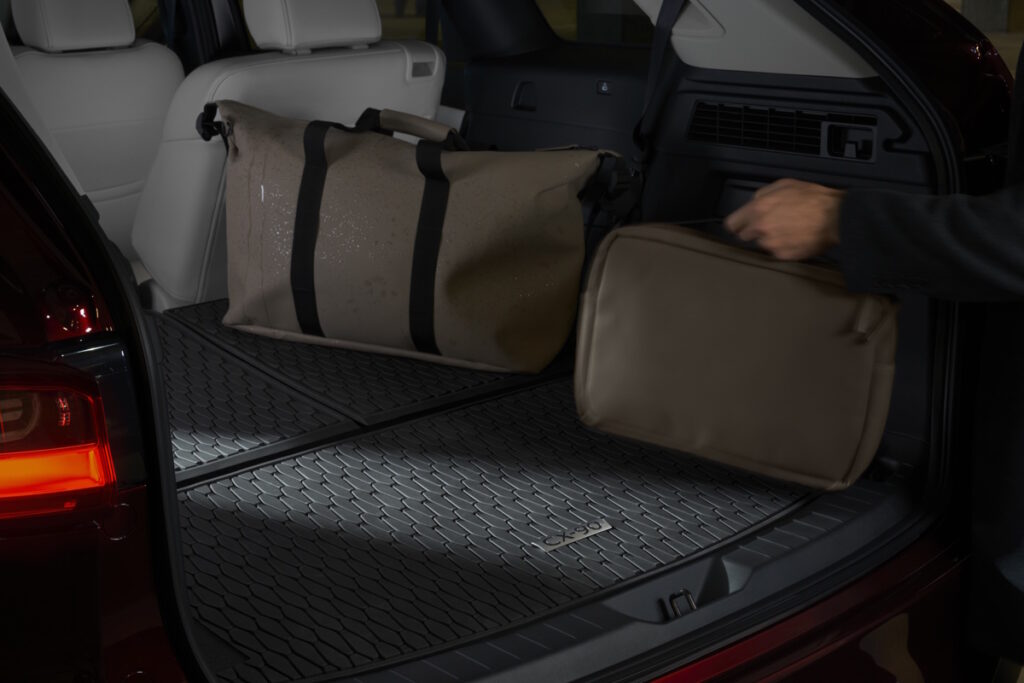
Should you buy a Mazda CX-90?
The 2025 Mazda CX-90 S Premium Plus is a three-row SUV for those who love to drive, yet also crave comfort and style for their family journeys. In many ways, it hits its marks: the cabin is stylish and comfortable, the exterior exudes class, and the performance can legitimately put a smile on an enthusiast’s face on a winding road. It’s a rare feat in this segment to combine sports-sedan dynamics with seven-passenger capability, and Mazda has pulled it off with the CX-90’s taut handling and smooth inline-six power. Long trips are made easier by the cushy seats and the upscale ambiance, and you’ll appreciate the little luxuries like the head-up display and surround-view camera when daily life demands it. Mazda also deserves credit for pushing into new territory. The Mazda CX-90 feels like a genuine alternative to a luxury SUV, without the luxury badge.
However, in striving for the top, Mazda has also revealed a few Achilles’ heels. The transmission shifter design is one glaring example: it’s unconventional to the point of being annoying (you literally have to pause in Reverse on your way to Drive, and if you’re not careful with the brake, the vehicle might lurch the wrong way). That’s a quirk nobody asked for, and it takes some acclimation to avoid “unexpected” movements. Additionally, while much of the interior feels luxurious, a couple of trim pieces and the overall tightness of space remind you that this is not a full-fledged luxury liner – it’s built to a price, and a family-focused Kia or Toyota will serve up more room for less money.
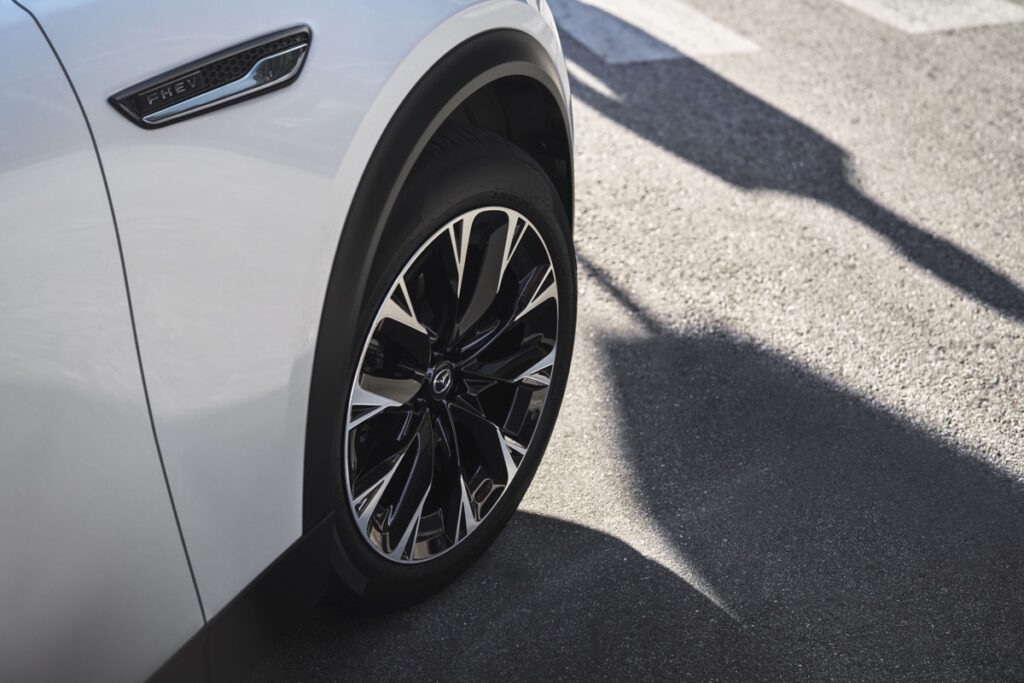
After a week with the Mazda CX-90 S Premium Plus, I find a lot to love in Mazda’s flagship SUV. It’s a statement that Mazda is unafraid to punch above its weight, delivering a vehicle that caters to driving enthusiasts in a segment usually ruled by practicality. If you’re the kind of driver who values a finely tuned chassis, a bit of character in your daily commute, and a cabin that looks like it was crafted rather than simply assembled, the CX-90 will speak to you. It nails the trifecta of comfort, style, and performance that we seek in an upper-trim SUV, and does so with an identity that’s distinct from the cookie-cutter family haulers. Just be aware that the same singular focus on driving enjoyment brings a firmer ride and a couple of design eccentricities that you’ll need to live with. In a market of excellent three-row SUVs, the 2025 Mazda CX-90 stands out as the driver’s choice, a rewarding and refined machine that makes even the school run feel a bit more special. It may not be perfect, but it’s an ambitious step for Mazda and an appealing option for those wanting a dash of zoom-zoom in their family SUV. In short, Mazda’s upscale gamble has largely paid off, and the Mazda CX-90 S Premium Plus is proof that you can have a family SUV that doesn’t forget to indulge the person behind the wheel.
Photos Courtesy of Mazda USA



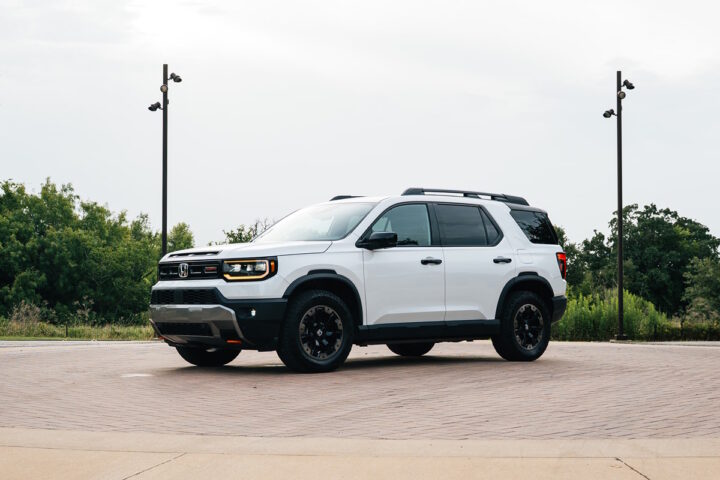
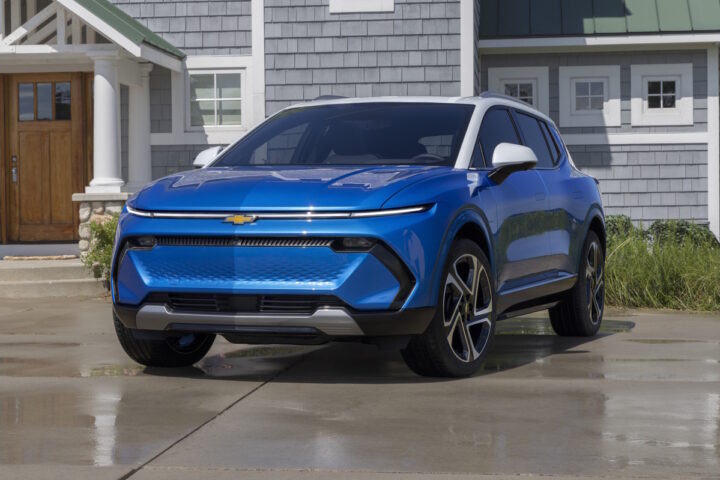

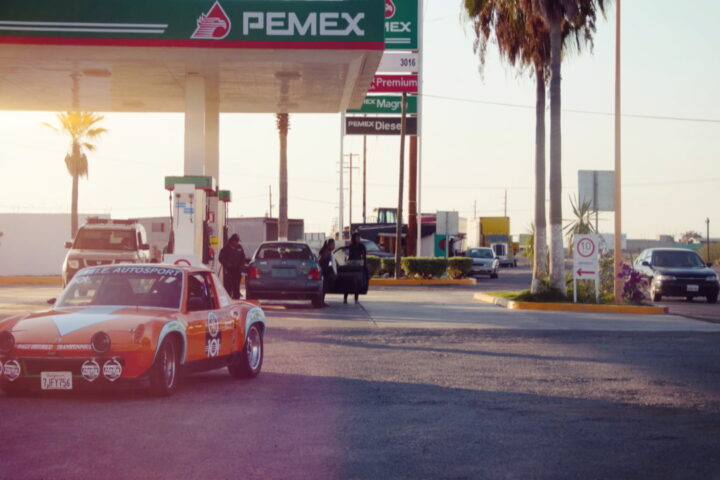
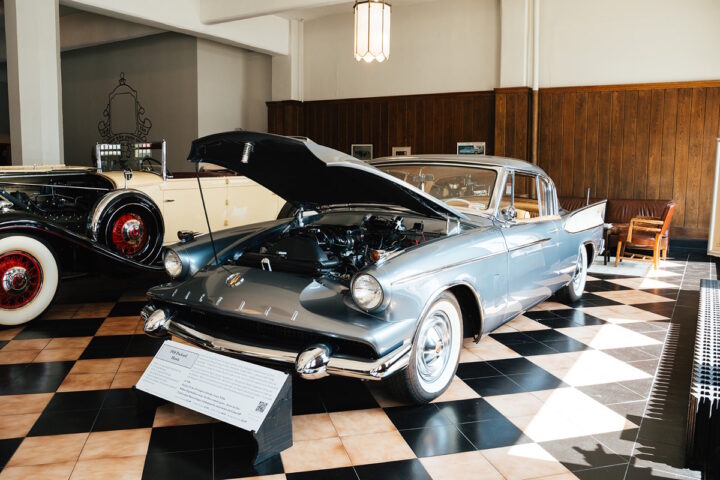
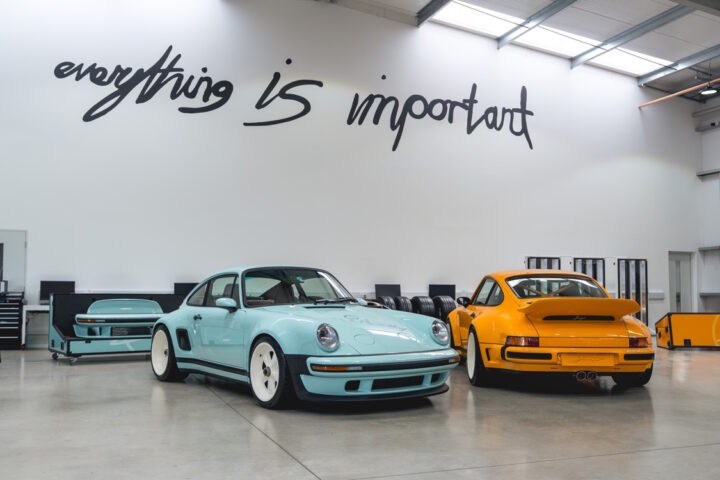
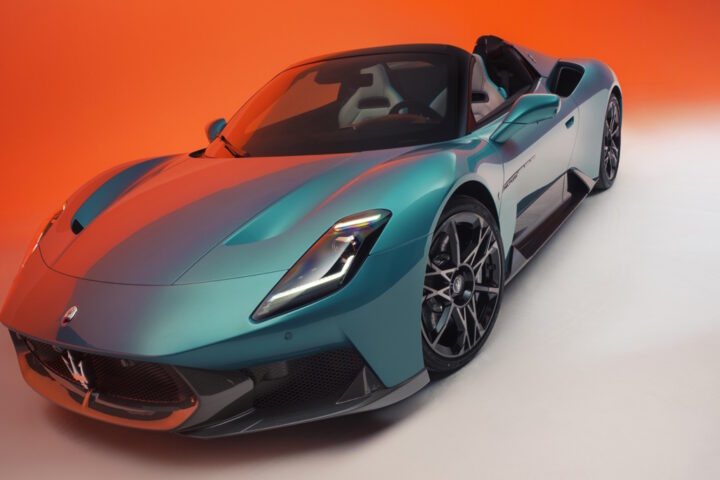
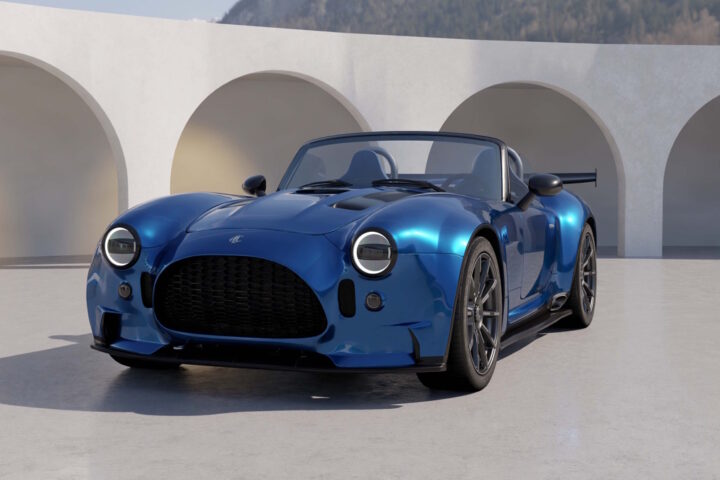




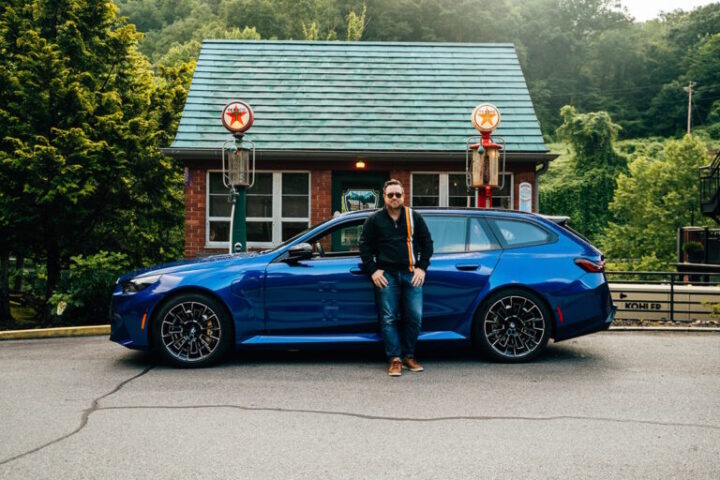

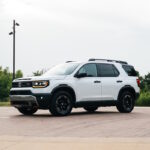
I just like the helpful information you provide in your articles
This site is so awesome! I love reading the reviews, this website is my go to for car culture and reviews.
Something this big from Mazda feels wrong
The answer is always Miata… this is no Miata, but it might make a good tow vehicle.